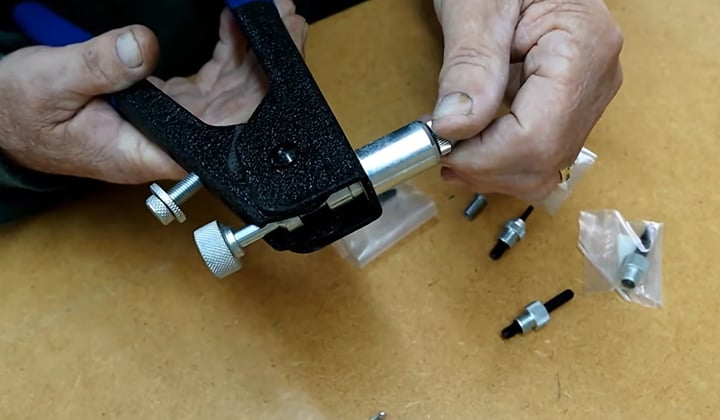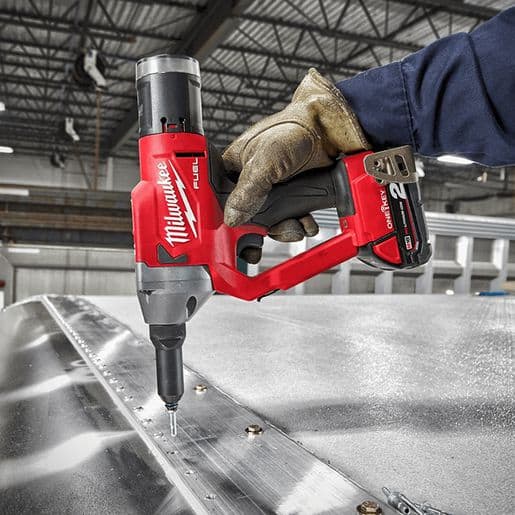If you’re working on a house renovation job, you may be facing rivet nut issues and you’re undoubtedly mindful of how time-consuming it is. Luckily you can easily solve this problem by using a rivnut tool.
Rivnut tool is a powerful tool that is designed to put bolts or rivets in materials that cannot normally take threaded bolts. In modern times, the rivnut is used in a wide variety of industries, including appliances, electronics, automotive manufacture, and solar installations, as well as office furniture, playground equipment, and plastics.

However, we’ve been studying what we can accomplish with this magical weapon up to this point; now it’s time to learn how to use it. Operating a rivnut tool is as easy as snapping your finger, but there are certain guidelines to follow. If you don’t, you’ll end up damaging your work and maybe injuring yourself. Many of you ask me ” How Do I Use A Rivnut Tool ?”.So, in this essay, I’ll show you how to utilize this powerful tool properly step by step.
In this post we'll cover:
What is Rivnut
A rivet nut is a specific type of rivet that is also called a blind rivet nut, a threaded insert, a rivnut, or a nutsert. They are incredibly durable and made of sheet metal, brass, and steel. It has a cylindrical shape and it’s internally threaded counterbored allowing it to be driven from one side like a blind rivet. Rivet Nut Tools are available in a range of forms and sizes, as they are quite popular among crafters and widely utilized.
What is Rivnut Tool
A rivnut tool is a specific sort of power tool that is used to insert rivet nuts into materials that aren’t suitable for threaded bolts. Rivet Nut tools are also quite popular among crafters since they are produced in large quantities and come in a variety of shapes and sizes, including hand tools, spin tools, and pool tools.
How Does A Rivnut Tool Work
The working principle of a rivet nut tool is pretty simple. You just have to insert the rivet nut into the hole of the attached element. The riveting tool will push up the nut thread through the mandrel, by providing a downward force and allowing the screw to be fixed. We’ll study it extensively in the following section of this text.
How To Use A Rivnut Tool
Here some steps for using a rivet nut tool are given below. By following these steps you can run a rivet nut tool easily.
- Choose the right rivet nut for your work
- Make sure you have got a flat surface
- Get a nutset that will fill the hole
- Assembling rivet nut tool
- Threading and socket positioning
- Install bolt after turning the ratchet

Step 1: Choose The Right Rivnut Tools For Your Work
At first, you have to find the right rivnut tool which will be compatible for your job. In today’s market, there are a variety of rivnut tools to choose from including hand tools, spin tools, pull tools.
- Hand Tools – It’s a little smaller Rivet Nut tool that is threaded by using a mandrel. And this tool is used to fit into a workpiece.
- Spin Tools – It’s a pneumatic tool that is also threaded by using a mandrel. And this tool is beneficial for plastic workpieces and other applications.
- Pull Tools – This tool is similar to Spin Tools. When working with metal or hard polymers, this is the tool to utilize.
You must choose your rivnut tool based on your work requirements.
Step 2: Choose The Right Rivet Nut
You must be careful while choosing a rivet nut. Rivet nuts are available in a variety of sizes and shapes, including square, hexagonal, and the traditional smooth, spherical form. Also, there are different head style rivet nuts available. For soft materials like plastic, fiberglass, or aluminum, a wedge head is ideal. The wide front-side flange has an enormous load-bearing surface. Thick Flange offers extra capacity and pulling capability.
Step 3: Make Sure You Have Got A Flat Surface
It is necessary to have a level surface. The surface you’re planning to put it on has to be completely flat. The primary reason for this is that it needs to fit tightly into the nutter’s shoulder. If the plate was scratched or twisted in any way. It’s unlikely that you’ll find the ideal mating location right soon. So you must ensure that you have a flat surface.
Step 4: Get A Nutset That Will Fill The Hole
What you need to do is drill with the nut sets. Some themes will be labeled, while others will just require the use of calipers to determine the nut set’s seized. Make sure you measure the top all the way around. Because some of them are a little twitchy
Step 5: Assembling Rivet Nut Tool
You must have to check if the Rivet Nut tool is assembled or not. If it’s not assembled then we have to assemble it. Carefully pull the rivet nut tool’s slide. Identify the nut and put the rivet nut finger in it. In the hole, place the stabilizing rod. Then, install the rivet nut on this hole and screw the slide to enable the ramp to pull up a little bit. Due to the thickness of the substance, the slide should be retracted approximately 0 to 1/4 inch.
Step 6: Threading and Socket Positioning
The rivet nut is then threaded into the mandrel, and the socket is then attached to the ratchet. Continue turning the rivet clockwise until the nut’s curved head is tightly against the tool’s bottom holding nut. To pull the tool’s nut, attach the appropriate size sockets to the ratchet. Insert the right size rivet nut into the metal hole. Tighten the rivet nut using your flexible wrench. After that, the socket will be inserted into the top of the drawing nut.
Last Step: Install Bolt After Turning The Ratchet
Apply counterclockwise pressure to the adjustable wrench while pulling the ratchet clockwise until the rivet nut is securely fastened. Then reverse the ratchet’s direction and turn the drawing nut counter-clockwise by using your hand. This will make it easier to remove the mandrel from the rivet nut. Then, to keep your rivet nut from spinning in the metal, place a bolt into it.
Frequently Asked Questions (FAQs)
Q: Can I use a regular rivet gun for rivnuts?
Answer: Yes you can. But for this, you must have a rivet gun that has the proper insert dies to accommodate the rivnuts.
Conclusion
If a threaded hole is required on the truck and other methods of attachment are not effective, you can use the methods described above to attach rivet nuts to steel, plastic, or other materials. Follow these steps and you will be able to use the tool on a regular basis.
I'm Joost Nusselder, the founder of Tools Doctor, content marketer, and dad. I love trying out new equipment, and together with my team I've been creating in-depth blog articles since 2016 to help loyal readers with tools & crafting tips.

